Experimental Relocation of the Mitochondrial Gene to the Nucleus Reveals Forces Underlying Mitochondrial Genome Evolution
Only a few genes remain in the mitochondrial genome retained by every eukaryotic organism that carry out essential functions and are implicated in severe diseases. Experimentally relocating these few genes to the nucleus therefore has both therapeutic and evolutionary implications. Numerous unproductive attempts have been made to do so, with a total of only 5 successes across all organisms. We have taken a novel approach to relocating mitochondrial genes that utilizes naturally nuclear versions from other organisms. We demonstrate this approach on subunit 9/c of ATP synthase, successfully relocating this gene for the first time in any organism by expressing the ATP9 genes from Podospora anserina in Saccharomyces cerevisiae. This study substantiates the role of protein structure in mitochondrial gene transfer: expression of chimeric constructs reveals that the P. anserina proteins can be correctly imported into mitochondria due to reduced hydrophobicity of the first transmembrane segment. Nuclear expression of ATP9, while permitting almost fully functional oxidative phosphorylation, perturbs many cellular properties, including cellular morphology, and activates the heat shock response. Altogether, our study establishes a novel strategy for allotopic expression of mitochondrial genes, demonstrates the complex adaptations required to relocate ATP9, and indicates a reason that this gene was only transferred to the nucleus during the evolution of multicellular organisms.
Published in the journal:
. PLoS Genet 8(8): e32767. doi:10.1371/journal.pgen.1002876
Category:
Research Article
doi:
https://doi.org/10.1371/journal.pgen.1002876
Summary
Only a few genes remain in the mitochondrial genome retained by every eukaryotic organism that carry out essential functions and are implicated in severe diseases. Experimentally relocating these few genes to the nucleus therefore has both therapeutic and evolutionary implications. Numerous unproductive attempts have been made to do so, with a total of only 5 successes across all organisms. We have taken a novel approach to relocating mitochondrial genes that utilizes naturally nuclear versions from other organisms. We demonstrate this approach on subunit 9/c of ATP synthase, successfully relocating this gene for the first time in any organism by expressing the ATP9 genes from Podospora anserina in Saccharomyces cerevisiae. This study substantiates the role of protein structure in mitochondrial gene transfer: expression of chimeric constructs reveals that the P. anserina proteins can be correctly imported into mitochondria due to reduced hydrophobicity of the first transmembrane segment. Nuclear expression of ATP9, while permitting almost fully functional oxidative phosphorylation, perturbs many cellular properties, including cellular morphology, and activates the heat shock response. Altogether, our study establishes a novel strategy for allotopic expression of mitochondrial genes, demonstrates the complex adaptations required to relocate ATP9, and indicates a reason that this gene was only transferred to the nucleus during the evolution of multicellular organisms.
Introduction
Mitochondrial genomes are remnants of an ancestral prokaryotic genome that has been considerably reduced in size during the evolution of eukaryotes because of a massive loss of redundant information and gene transfer to the nucleus. Today, the main function of mitochondrial genomes is the production of a few proteins involved in oxidative phosphorylation. It is not fully understood why the mitochondrial genome has been maintained throughout two billion years of evolution. There are only two genes always found in mitochondrial genomes: those encoding cytochrome b and Cox1p, subunits of respiratory complexes III and IV respectively [1]. The other genes can be found in either mitochondrial or nuclear DNA, and sometimes in both genomes like ATP9, which encodes subunit 9/c of ATP synthase [2] (this protein is called Atp9p in yeast; in other organisms we will henceforth refer to it as subunit 9). Several hypotheses have been proposed to account for the retention of DNA in mitochondria. One theory is that the transfer of genes from mitochondria to the nucleus is still underway [3]. Alternatively, genes may have been confined to mitochondria due to the difficulty of transporting their protein products into the organelle, an idea that stems from the enrichment of genes encoding hydrophobic proteins in organellar genomes [4]. Other views suggest that rather than being trapped in organelles, genes may have been preferentially maintained there to adjust gene expression according to the redox [5]–[7] or metabolic [8] state of mitochondria; this could ensure optimal energy transduction while minimizing the production of harmful reactive oxygen species.
An apt organism for assessing these theories is the yeast Saccharomyces cerevisiae, a facultative aerobe where both the nuclear and mitochondrial genomes can be easily manipulated. This organism can therefore be used to test allotopic expression, i.e., whether a mitochondrial gene can be functionally transferred to the nucleus. This assay involves inactivating the mitochondrial gene by mutation and testing a nuclear version of that gene for its capacity to restore respiratory function. This test has been carried out for five yeast proteins, two hydrophilic: bI4, an intron-encoded RNA maturase [9], and Var1p, a subunit of the mitochondrial ribosome [10], and three hydrophobic: the Atp8p subunit of mitochondrial ATP synthase with one transmembrane domain [11], the Cox2p subunit of respiratory complex IV (cytochrome c oxidase) which has two transmembrane segments [12], and the cytochrome b subunit of respiratory complex III, which is a highly hydrophobic protein with eight transmembrane segments [4]. In the cases of bI4, Var1p and Atp8p, adding a mitochondrial targeting sequence (MTS) and adjusting the genetic code were sufficient for functional allotopic expression of these proteins from nuclear DNA. The relocation of COX2 required a minimal change to the structure of the protein: a single tryptophan to arginine substitution within a transmembrane segment. Conversely, attempts to relocate the cytochrome b gene have been entirely unsuccessful. Altogether, these findings do not refute the hypothesis that mitochondrial gene transfer may still be underway, but they also support the theory that some genes face an insurmountable barrier to functional relocation, such as the cytochrome b gene which is universally present in mitochondrial genomes.
In this study, our aim was to allotopically express the ATP9 gene in S. cerevisiae. The protein it encodes has only two transmembrane segments, yet is extremely hydrophobic and classified as a proteolipid because it can easily be extracted from mitochondria with organic solvents [13]. Subunit 9 is present in several copies (ten in yeast [14]), forming a ring structure that is an essential component of the ATP synthase proton-translocating domain (FO). During proton transport, the subunit 9-ring rotates, resulting in conformational changes that favour the production of ATP by the catalytic head of the ATP synthase (F1) and its release into the mitochondrial matrix [15], [16].
As ATP9 is naturally present in the nuclear DNA of a number of organisms, including filamentous fungi [2] and most animals [17], it is clear that there is no insurmountable barrier to functional relocation of this gene from mitochondria to the nucleus. A previous study has shown that the yeast Atp9p fused to a MTS can be imported and processed in vitro by mitochondria isolated from wild-type yeast [18], but to date there exists no description of a successful in vivo experiment. Here we take a novel approach that achieves allotopic expression of subunit 9 in yeast by using naturally nuclear genes from the filamentous fungus Podospora anserina. We use an array of techniques to demonstrate that substantial adaptations, including a reduction in hydrophobicity, are required for functional nuclear expression of this protein.
Results
Nuclear Versions of the Yeast Mitochondrial ATP9 Gene Fail to Rescue Δatp9 Yeast
As a first step in its nuclear relocation, we deleted the ATP9 gene from the yeast mitochondrial genome using the ARG8m selection marker [19]. This was performed in a Δarg8 derivative of W303-1B, henceforth designated as WT (strain MR6 [20], all genotypes in Table 1). The Δatp9 strain was thus selected for its capacity to grow in the absence of external arginine (Figure 1A) and proper integration of ARG8m at the ATP9 locus was verified (Figure S1). As expected, Δatp9 yeast is unable to grow on glycerol (Figure 1A) and devoid of assembled ATP synthase (Figure 1B). As has previously been observed in other yeast ATP synthase mutants, the Δatp9 yeast also displayed several additional mitochondrial defects: (i) deficient synthesis of several mitochondrially-encoded proteins (Cox1p, Atp6p and Atp8p, Figure 1C); (ii) dramatically reduced amounts of respiratory complexes III and IV (<10% of WT levels, Figure S1E); (iii) aberrations in mitochondrial morphology including the absence of cristae and the presence of numerous septae within the mitochondrial matrix (Figure 1D); and (iv) decreased mtDNA stability leading to increased production of cytoplasmic petites resulting from large (>50%) deletions (ρ−) or complete loss (ρ0) of mtDNA (50–70% vs. <5% in WT) (see [20] and [21] and references therein for explanations of these secondary consequences).
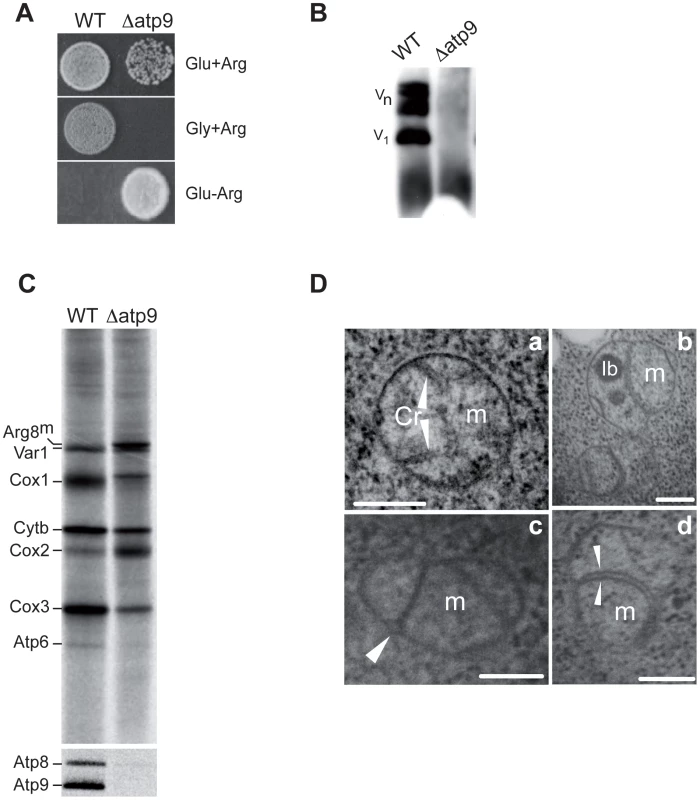
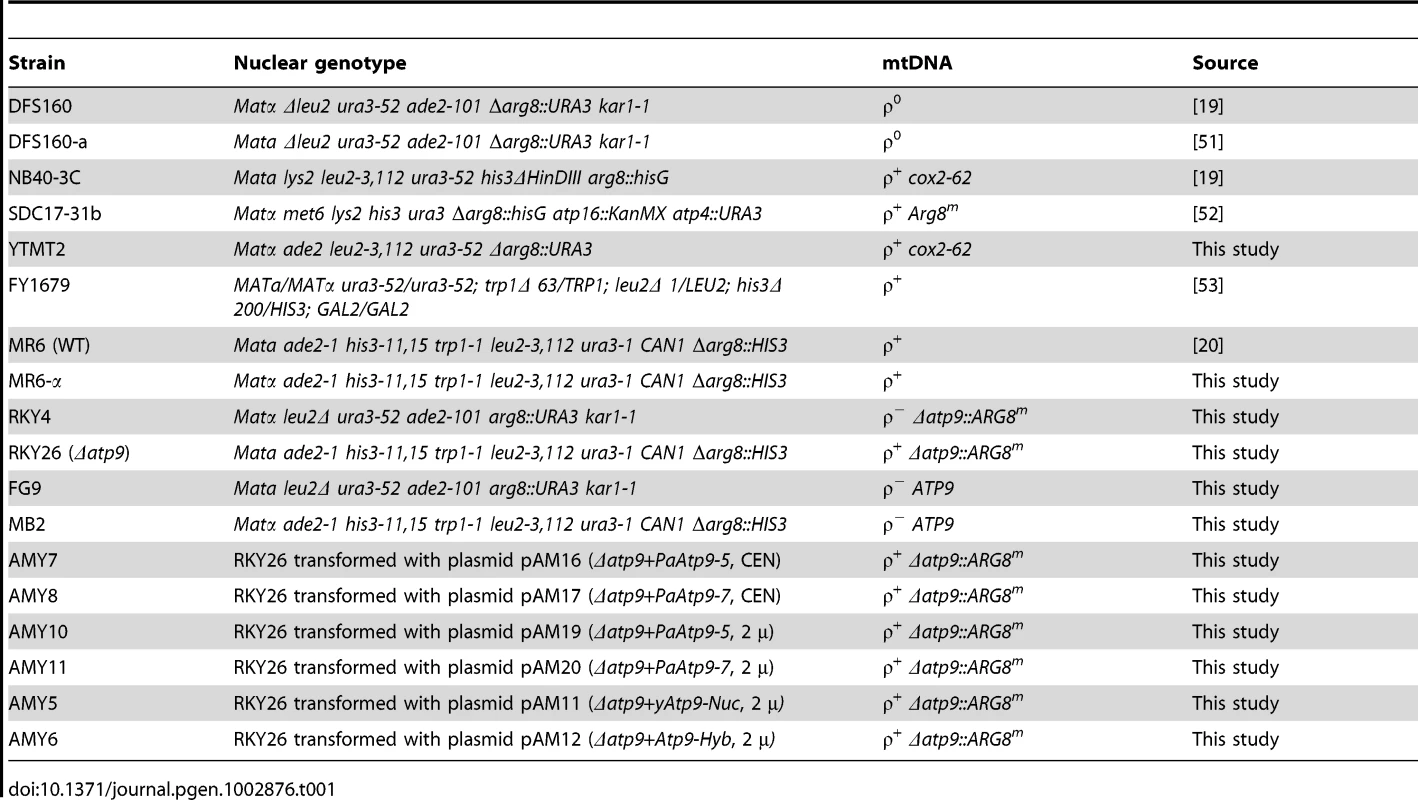
In order to express the yeast ATP9 gene from nuclear DNA, we synthesized a version codon-optimized for nuclear expression in yeast and fused to a mitochondrial targeting sequence (MTS) from the subunit 9 precursor encoded by the nuclear gene PaAtp9-7 in P. anserina (named yAtp9-Nuc, Figure S2 and S3A). In this filamentous fungus, subunit 9 is produced by two different nuclear genes, PaAtp9-7 and PaAtp9-5, that are differentially expressed during its life cycle [2]. When tested on a recoded yeast ATP8 gene, which can be functionally expressed from nuclear DNA [17], we found the PaAtp9-7 MTS to be effective in yeast, as evidenced by a complete rescue of a Δatp8 strain (not shown). This experiment supports our design of the yAtp9-Nuc and its MTS (detailed in Figure S2), which we based on subunit 9 in Neurospora crassa [22]. Nonetheless, upon transformation with yAtp9-Nuc, Δatp9 yeast did not grow on respiratory substrates even after more than 20 days (Figure 2A). Using antibodies against yeast Atp9p, only a protein with the size of the unprocessed yAtp9-Nuc was detected in very small amounts and exclusively in mitochondria (Figure 2B). This indicates that yAtp9-Nuc is targeted to mitochondria, but cannot cross the mitochondrial inner membrane. Since the levels of this protein are so low, we hypothesized that it had been degraded, most likely by the i-AAA protease (a homo-oligomer of Yme1p) that preferentially degrades membrane proteins and whose catalytic site faces the intermembrane space [23]. We confirmed the i-AAA-mediated degradation of yAtp9-Nuc by expressing the latter protein in a Δyme1 strain. In this strain, the unprocessed protein was far more abundant, while the mature form remained almost absent. These observations verify the defective in vivo transport of yAtp9-Nuc across the inner membrane as well as its rapid degradation in the intermembrane space (Figure 2C).
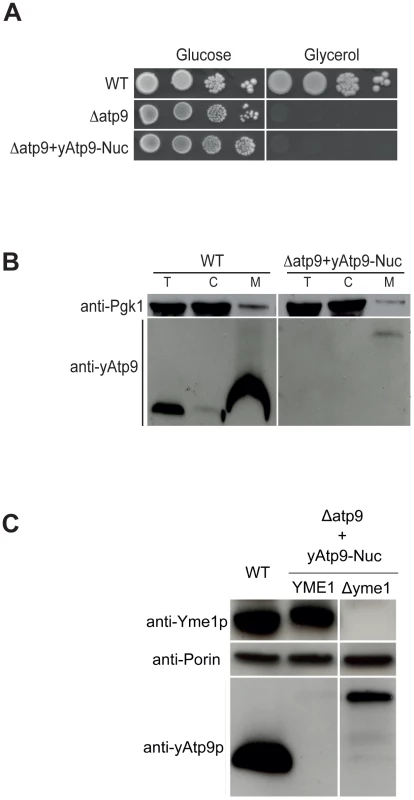
Nuclear Expression of P. anserina Atp9 Genes Complements Δatp9 Yeast
We next tested allotopic expression of subunit 9 in yeast using the naturally nuclear Atp9 genes from P. anserina (PaAtp9-7 and PaAtp9-5). The subunit 9 proteins encoded by these genes display 70% amino acid sequence identity with yeast Atp9p (Figure S2). We designed synthetic PaAtp9-5 and PaAtp9-7 genes codon-optimized for high expression levels in yeast under control of the Tet-off (doxycyclin-repressible) promoter and cloned into both centromeric (pCM189, CEN) and multicopy (pCM190, 2 µ) plasmids (see Figure S3B–C for nucleotide sequences). Upon transformation with each of these plasmids (pAM17 (PaAtp9-7, CEN), pAM20 (PaAtp9-7, 2 µ), pAM16 (PaAtp9-5, CEN) and pAM19 (PaAtp9-5, 2 µ)), the Δatp9 strain regained respiratory capacity, although not to the extent of the WT (Figure 3A). The PaAtp9-5 gene enabled better growth than PaAtp9-7, and for both genes, the multicopy plasmid was more effective than the centromeric one. Consistent with the growth measurements, PaAtp9-5 confers more effective mitochondrial functions related to oxidative phosphorylation than PaAtp9-7, as evidenced by the analysis of strains AMY10 (Δatp9+PaAtp9-5, 2 µ) and AMY11 (Δatp9+PaAtp9-7, 2 µ) (Table 2). The oxygen consumption rates in AMY10 and AMY11 mitochondria (at state 3 with NADH as an electron donor) were respectively estimated at 80% and 40% of the WT rate, and the rates of ATP synthesis at 50% and 25%. This decrease in oxidative phosphorylation capacity is mainly due to reduced amounts of respiratory complexes and assembled ATP synthase (Figure 3B). Oligomeric forms of the ATP synthase were much less abundant than the monomeric form in AMY10 and AMY11 (shown for AMY10 in Figure 3B).
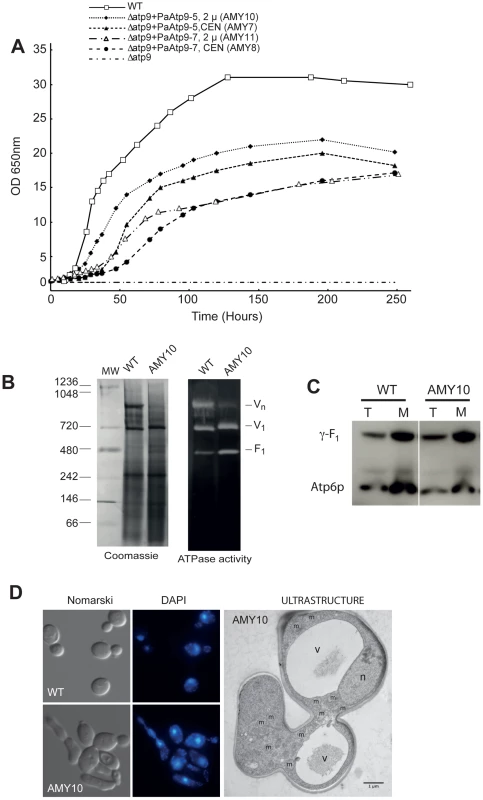
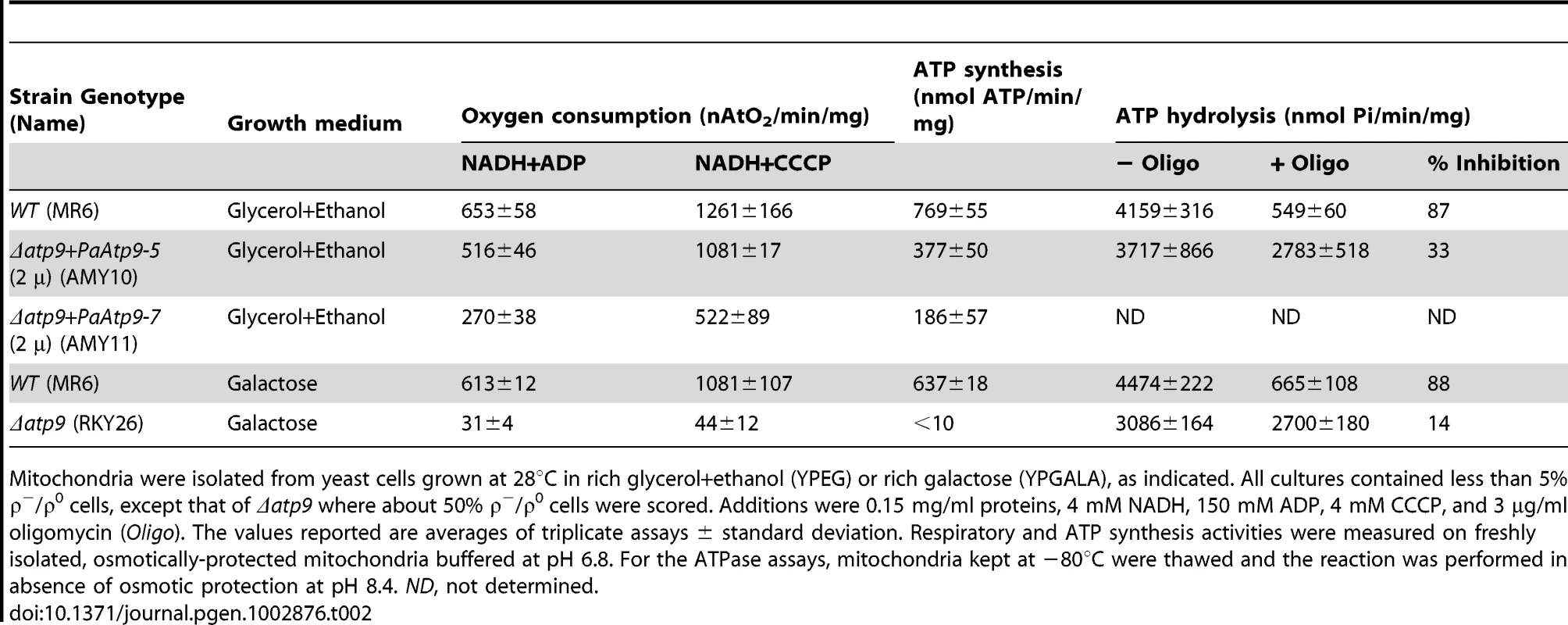
The reduced ATP synthase levels in the strains expressing the P. anserina genes could be due to poor expression, transport, processing or assembly of subunit 9; our evidence indicates the latter is responsible. In a previous study [24], we found that the centromeric pCM189 plasmid enabled sufficient expression of yeast ATP synthase subunit δ, present at one copy per ATP synthase complex. The expression level of the PaAtp9 genes from the multicopy plasmid pCM190 should thus be sufficient to produce the ten required copies of Atp9p per ATP synthase complex. Unfortunately, our yeast Atp9p antibodies did not recognize the P. anserina proteins (see Figure S2), and attempts to raise antibodies directly against PaAtp9-5 and PaAtp9-7 were unsuccessful. We constructed HA-tagged version of these proteins, but they failed to complement Δatp9 yeast. We were therefore unable to directly assess the levels of processed, unprocessed, and unassembled subunit 9 by western blot. Yet several lines of evidence indicate that FO assembly was less effective with the PaAtp9 proteins. One is the reduced sensitivity of mitochondrial ATPase activity to oligomycin, a specific FO inhibitor, in these strains (<40% vs. 80% for WT, Table 2). As Atp9p is a constituent of the FO and the F1 can assemble independently of FO [25], inefficient expression of the PaAtp9-7 and PaAtp9-5 proteins would cause free F1 to accumulate, reducing the sensitivity of mitochondrial ATPase activity to oligomycin. A lower yield of FO is additionally supported by higher levels of free F1 in the mitochondria of the modified yeast strains than in WT (BN-PAGE for AMY10 in Figure 3B) and by diminished Atp6p levels (30–50%), while γ -F1 protein levels were unaffected in both total and mitochondrial protein extracts (Figure 3C). As Atp6p is rapidly degraded when it cannot be incorporated into ATP synthase [26], the steady state level of this protein is a good indicator of the amount of assembled subunit 9-ring. The subunit 6 deficiency correlates with the respective reductions in the rate of ATP synthesis in the yeast strains expressing the PaAtp9 genes. On the other hand, the catalytic efficiency of ATP synthesis (number of ATP molecules synthesized per electron transferred to oxygen) was comparable to that of WT yeast (Table 2), meaning that once in the ATP synthase complex the PaAtp9-5 and PaAtp9-7 proteins properly interact with other FO components and the F1 sector. These results show that the reduced sensitivity of mitochondrial ATPase activity to oligomycin and the higher levels of free F1 in the modified yeast strains are most likely due to an imbalanced production of FO and F1, which is a result of less efficient Fo assembly in these strains.
ATP synthase is known to be far from limiting for respiratory growth in yeast, since a deficit in its activity of at least 80% is required before a growth defect can be observed [27], [28]. Thus, it was expected that with respective ATP synthesis levels of 50% and 25%, AMY10 and AMY11 would grow far better than we observed. This discrepancy is likely because expressing the PaAtp9-5 and PaAtp9-7 genes causes deleterious side effects in yeast. For example, the modified yeast strains displayed aberrant, pseudohyphal cell morphology when grown in glycerol and ethanol medium (shown for AMY10, Figure 3C). It is not clear how this phenotype arises, but it very likely impedes respiratory growth of Δatp9 yeast expressing the PaAtp9 genes.
Reducing the Hydrophobicity of the First Transmembrane Segment of Subunit 9 Is Required for Its Nuclear Expression
The results described above are evidence that structural modification of subunit 9 is required for functional expression of this protein from nuclear DNA. A striking difference between the PaAtp9 proteins and yeast Atp9p is reduced hydrophobicity in the first transmembrane segment of the former, as indicated by hydropathy plots (Figure 4A). Additional evidence of reduced hydrophobicity results from comparing the resistance of the subunit 9-ring to detergents in P. anserina and yeast. To make this comparison, we enriched mitochondrial extracts for ATP synthase from engineered P. anserina strains expressing only PaAtp9-7 or PaAtp9-5 (details in Text S1). On a denaturing SDS gel, the PaAtp9 proteins were both detected only as monomers, whereas yeast Atp9p was mainly present as oligomeric rings (Figure 4B). These results indicate that the inter-subunit interactions responsible for maintaining the subunit 9-rings are significantly less hydrophobic in P. anserina than in yeast.
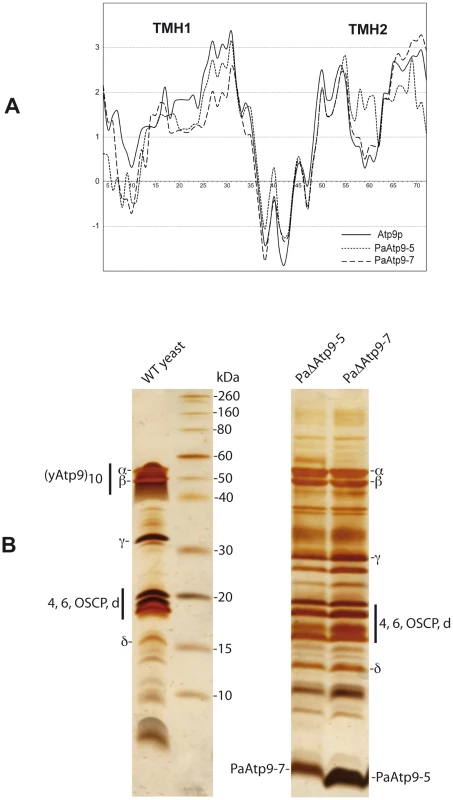
To test whether hydrophobicity of the first transmembrane segment of subunit 9 affects expression of this protein from nuclear DNA, we designed a hybrid gene (Atp9-Hyb) encoding the MTS and first transmembrane segment of the PaAtp9-7 protein, followed by the connecting loop and second transmembrane segment of yeast Atp9p (see Figure S2 and S3D for protein and nucleotide sequences). Although Δatp9 yeast expressing Atp9-Hyb grew extremely slowly on glycerol (not shown), some processed hybrid protein was detected in mitochondria (Figure 5) whereas, as shown above (Figure 2B), only trace amounts of unprocessed protein were detected in Δatp9 yeast expressing a nuclear version of the endogenous yeast ATP9 gene. Taken together, these data indicate that the high hydrophobicity of the first transmembrane segment of yeast Atp9p prevents its translocation across the mitochondrial membranes from the cytosol.
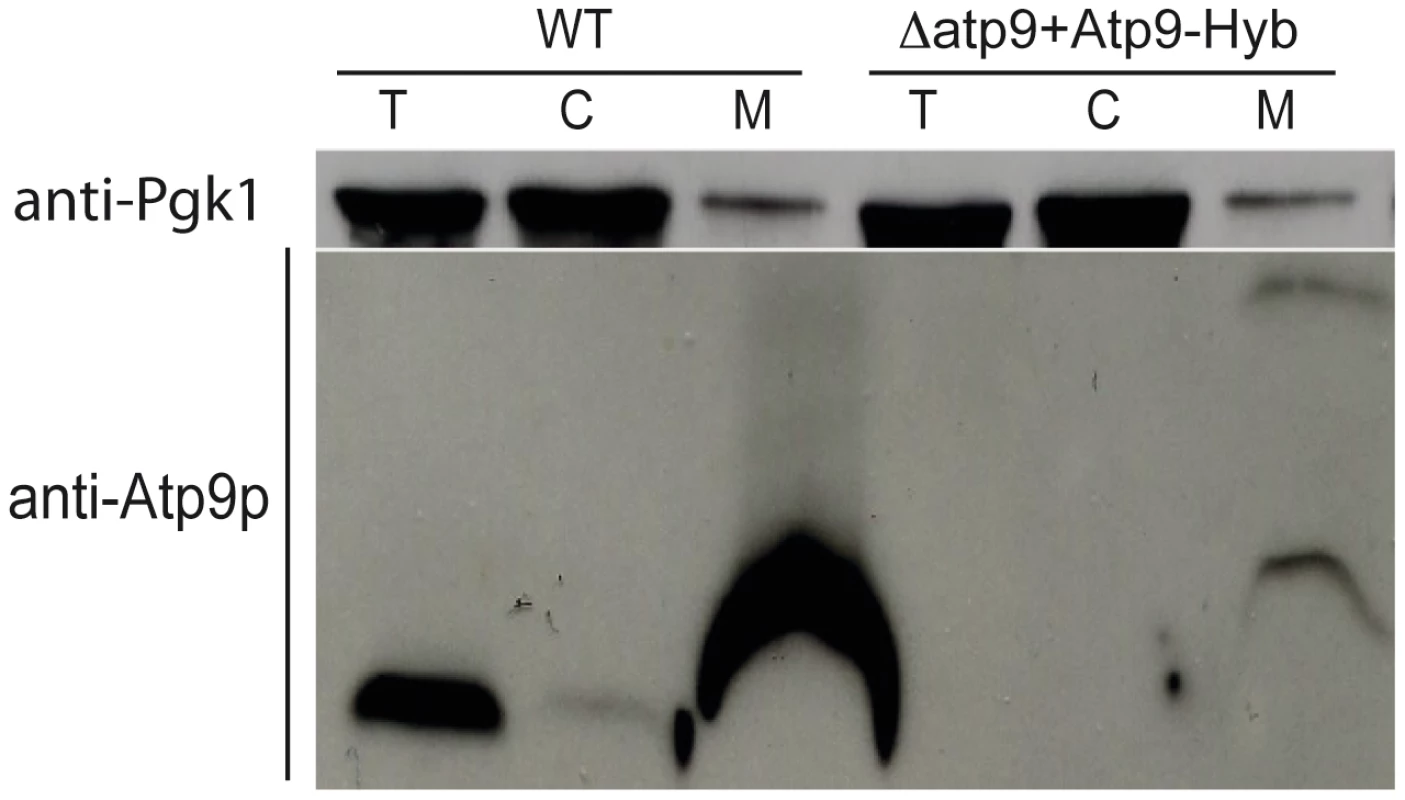
Transcription Profiling Reveals Regulatory Consequences of ATP9 Relocation
To investigate the effects of expressing the P. anserina ATP9 genes in Δatp9 yeast at a cellular level, we carried out whole-genome transcription profiling using high-resolution tiling microarrays (data browsable at http://steinmetzlab.embl.de/atp9/; results of analysis in Dataset S1; raw data in ArrayExpress database; functional analysis in Figure 6; intercorrelation of samples in Figure S4). Notably, no functions related to oxidative phosphorylation are enriched in genes differentially expressed between any of the relocation strains and WT (Figure 6), indicating that the complementation is mostly sufficient for the function of the respiratory chain. The only genes directly involved in OXPHOS whose expression changes when ATP9 is relocated are QCR9 and NCA3. Since the latter regulates translation of ATP6 and ATP8 [29] and the former may play a role in cytochrome bc1 biogenesis [30], the downregulation of these genes supports the biochemical indications of an overall decrease in respiratory chain biogenesis and assembly. Some signals of the retrograde response, a typical sign of respiratory deficiency, also suggest that the complementation is incomplete (Figure 6). At the cellular level, we also see evidence of the response to overproduction of a new hydrophobic protein in the cytoplasm via enrichment of the Gene Ontology term “response to temperature stimulus” (MGSA, posterior probability >0.85), which entails modulation of protein folding. Notably, the gene SSA3 is among the most strongly upregulated in the relocation strains, which encodes an HSP70 chaperone protein involved in co-translational protein-membrane targeting and whose overexpression protects a yeast model of Parkinson's disease from alpha-synuclein toxicity [31]; it is therefore possible that this protein helps to prevent toxic aggregation of the PaAtp9 proteins. The morphological abnormalities of the relocation strains are clarified by the transcription profiles, in particular by functional enrichments like “cell separation during cytokinesis” among downregulated genes (P = 0.003) and “cell-cell adhesion” among upregulated genes (P = 0.008) as well as enrichments for targets of the transcription factor PHD1 (MGSA, posterior probability >0.95), a master regulator of pseudohyphal growth (Figure 6). Taken together, the transcriptome data corroborate the biochemical observations while providing more specific insights into the cellular outcome of relocating ATP9 to the nucleus in yeast, particularly in terms of the difficulties in folding the foreign protein.
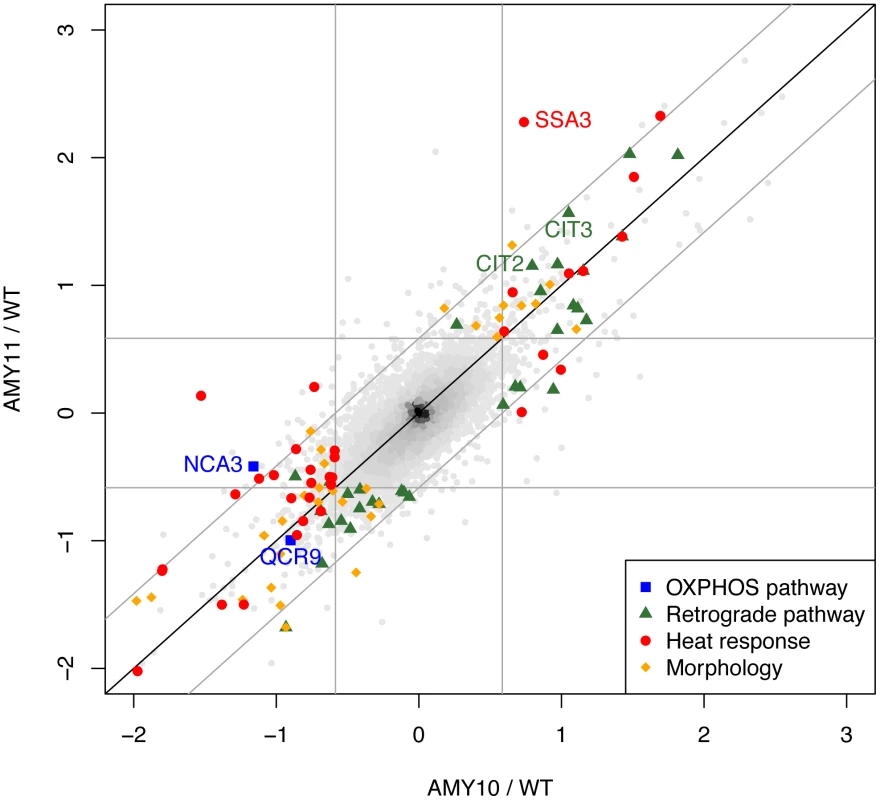
Discussion
Our study demonstrates that allotopic expression of the yeast mitochondrial ATP9 gene is possible, provided that sufficient modifications to the protein structure are made. Despite previous reports that yeast Atp9p can be imported by isolated wild-type mitochondria [18], we found that expressing the yeast ATP9 gene from nuclear DNA (yAtp9-Nuc construct, see Figure 2) does not restore in vivo respiratory function in a Δatp9 strain. Although the precursor protein is correctly targeted to mitochondria, it cannot cross the mitochondrial inner membrane and is degraded in the intermembrane space by the i-AAA protease (Figure 2).
We achieve allotopic expression of ATP synthase subunit 9 using the nuclear Atp9 genes of P. anserina (PaAtp9-5 and PaAtp9-7). Remarkably, despite only 70% sequence identity between these proteins and yeast Atp9p, the production of functional ATP synthase was significantly restored (30–40%) in Δatp9 yeast and the ‘hybrid’ enzymes displayed high catalytic efficiency. This indicates that the high hydrophobicity of yeast Atp9p relative to the P. anserina proteins impedes expression of the former from nuclear DNA. This constraint is also evident in the case of ATP synthase subunit 6, which contains five membrane-spanning segments. In the few species where this protein is nuclear-encoded, the first three transmembrane segments of subunit 6 are significantly less hydrophobic than the ones encoded by mitochondrial genomes [32]. Several of our results indicate that reducing the hydrophobicity of subunit 9 is also required for nuclear relocation. Hydropathy plots (Figure 4A) indicate significantly lower hydrophobicity in the first transmembrane segment of the P. anserina Atp9 proteins; in addition, the P. anserina subunit 9-rings can be dissociated much more easily with detergents than the yeast Atp9p-ring (Figure 4B). Finally, when substituting the first transmembrane segment of yeast Atp9p with that of the PaAtp9-7 protein (Atp9-Hyb construct), mature protein was detected in mitochondria (Figure 5), which was not observed with nuclear expression of the endogenous yeast ATP9 gene (Figure2B). From these results, we conclude that reducing the hydrophobicity of the first transmembrane segment of subunit 9 is necessary for this protein to cross the mitochondrial inner membrane, after which it can be inserted into the membrane and correctly folded for incorporation into ATP synthase (Figure 7). These results clearly demonstrate the importance of protein structure and hydrophobicity in transferring mitochondrial genes to the nucleus.
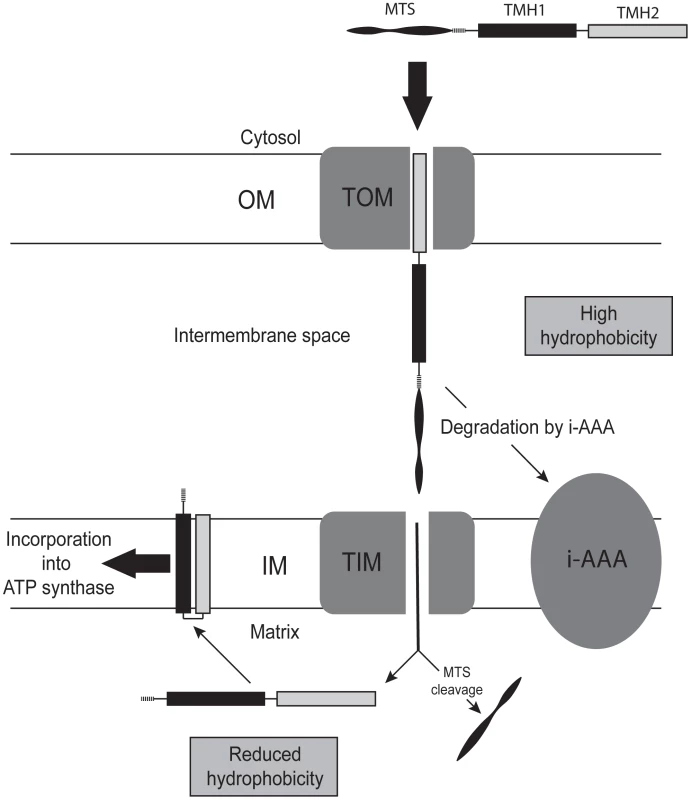
Additional adaptations beyond protein structure are required to optimize allotopic expression of subunit 9; in particular, transcriptional evidence of the retrograde response in the relocation strains indicates that their mitochondria are not functioning optimally (Figure 6). Indeed, although the ATP synthase in Δatp9 yeast expressing the P. anserina Atp9 genes is catalytically efficient, the yield in complex assembly is quite low compared to wild-type yeast (30–40%). One possible reason is that the P. anserina proteins are more exposed to proteases than the native yeast Atp9p, the latter being inserted into the membrane during its own synthesis in mitochondria [26]. The upregulation of SSA3 in the relocation strains, a gene that has been implicated in cotranslational import [31], may similarly have facilitated the transport of the PaAtp9 proteins across the outer mitochondrial membrane; this, however, would not protect them from mitochondrial proteases. In addition, yeast ATP synthase assembly is a remarkably evolved and sophisticated system: multiple factors execute highly specific functions ranging from synthesis to oligomerization of the individual subunits [25], [26]. The factors that assemble ATP9 depend on its expression from the mitochondria; it is therefore natural that this process would be less efficient when the protein is coming from an unexpected direction. Decreased biogenesis of ATP synthase is also supported by the reduced expression of NCA3, a gene that regulates expression of Atp6p and Atp8p [29]. Effective nuclear expression of subunit 9 may also require adaptations beyond mitochondrial biogenesis, as suggested by the aberrant cellular morphology of strains expressing the P. anserina Atp9 genes (Figure 3C). We have therefore undertaken the selection of mutations that improve allotopic expression of subunit 9, a strategy that could bring new insight into the mechanisms involved in organellar gene transfer during the evolution of eukaryotes. Exploration of these mechanisms holds promise for developing therapeutic strategies for human diseases caused by mitochondrial DNA mutations. There is no report thus far with strong functional and biochemical evidence that allotopically expressed proteins are properly incorporated into OXPHOS complexes in human cells [33], [34]. Our yeast-based approach has potential to unravel the general adaptations necessary for expressing mitochondrial proteins from nuclear DNA.
A recent survey of the ATP9 gene in 26 fungal species has revealed a strong diversity of genomic locations of this gene, especially in the Pezizomycotina subphylum which is comprised primarily of filamentous fungi [2]. Phylogenetic data indicate that early in the evolution of this group of fungi, ATP9 was transferred to the nucleus twice, which was eventually followed by independent mitochondrial gene loss events. As a result, five different distributions of the ATP9 gene between the nuclear and mitochondrial genomes can be found in filamentous fungi. The complete lack of functional expression of yeast Atp9p from the nucleus and partial complementation by a naturally nuclear version of this protein demonstrate that effective nuclear relocation of the ATP9 gene requires multifactorial adaptations; it would therefore probably not occur during evolution unless it conferred significant benefits to the organism. This idea is supported by a recent study in P. anserina where subunit 9 is produced by two nuclear genes (PaAtp9-5 and PaAtp9-7) and where the ancestral mitochondrial gene copy has been lost [2]. PaAtp9-5 is strongly expressed in germinating spores, where a high rate of ATP synthase production is necessary. In the sexual reproduction phase, when external nutrients become limited, the fungus ceases vegetative growth and produces spores. This phase does not require large quantities of neosynthesized ATP synthase, and subunit 9 is thus produced almost exclusively at a much lower level by PaAtp9-7. Complex regulation of ATP9 has also been observed in the filamentous fungus Neurospora crassa, where one nuclear copy of this gene co-exists with one mitochondrial version; this may be regarded as an intermediate stage of evolution at which the loss of the mitochondrial gene cannot be tolerated [35]. In mammals, as in P. anserina, subunit 9 is produced exclusively from multiple nuclear isogenes that are transcriptionally regulated to modulate its production in a cell- and tissue-specific manner [36]. A well-documented case is the pronounced downregulation of subunit 9 in the thermogenic brown adipose tissue (BAT) upon cold acclimation [37]. As a result, the amount of ATP synthase is decreased tenfold in BAT, and due to the concomitant induction of an uncoupling protein (UCP), the proton-motive force of the inner mitochondrial membrane is converted into heat rather than ATP.
It is clearly more effective for cells to respond to changes in their environment by modulating the activity of nuclear genes than mitochondrial genes, which are devoid of gene-specific transcriptional regulation [19], [38]. The ATP9-mediated regulation of ATP synthase production in fungi and mammals requires a nuclear location of this gene. Notably, the nuclear relocation of ATP9 occurred independently in fungi and mammals, and in both kingdoms the regulation of this gene was specialized such that it could modulate ATP synthase production according to certain environmental factors. An intriguing question is why this important regulatory function has been attributed to a gene that is so difficult to relocate to the nucleus. Many of the other structural genes of mitochondrial ATP synthase can be transferred much more easily, such as those encoding the F1 subunits that are, almost without exception, nuclear [1], [39]. Subunit 9 may be preferentially used as a regulatory target to modulate production of the enzyme because it can do so safely, without accumulating potentially harmful assembly intermediates. In mammals, it is the only subunit whose expression is transcriptionally regulated; when its expression is diminished, the other ATP synthase subunits that are in excess are eliminated by proteolytic degradation [38]. Due to its extremely hydrophobic nature, it may be safer to control subunit 9 at the level of synthesis rather than by proteolytic degradation, similarly to what has been reported for the Cox1p subunit of complex IV [40], [41].
As described in the introduction, several hypotheses have been proposed to account for the retention of DNA in mitochondria: (i) gene transfer from mtDNA is still underway; (ii) some genes have been confined to the organelle because expressing them from the nucleus would be problematic; and (iii) some genes have been preferentially retained in order to optimize mitochondrial function. In the case of ATP9, our study demonstrates that this gene can, in principle, be relocated to the nucleus in yeast; nevertheless, the adaptations required to optimize its nuclear expression are many and complex in nature. Thus, there must be a compelling reason for ATP9 to become nuclear, such as the requirement for more specialized regulation of ATP synthase activity by complex, multicellular organisms. Otherwise it would remain in the organelle, as in all unicellular organisms including S. cerevisae where ATP synthase expression is not subject to any specialized regulation beyond the general glucose-induced repression of respiratory functions [25]. Accordingly, we would like to introduce the hypothesis that variations in the gene content of mitochondria are influenced by not only protein structure, but also the lifestyle of the organism.
Materials and Methods
Yeast Strains and Culture Medium
The S. cerevisiae strains used and their genotypes are listed in Table 1. For details on growth procedures, see Text S1.
Deletion of the Mitochondrial ATP9 Gene
We deleted the ATP9 gene using the ARG8m-based procedure described by T. Fox and colleagues [19]. For details, see Text S1.
Synthetic ATP9 Genes
The coding sequences of all synthetic Atp9 genes used in this study (yAtp9-Nuc, PaAtp9-5, PaAtp9-7, and Atp9-Hyb) were designed for optimal expression in yeast using the Gene Designer sofware by DNA2.0 (www.dna20.com; corresponding amino-acid sequences in Figure S2; nucleotide sequences in Figure S3). The synthetic genes were first cloned into pJ204 and then into the yeast expression vectors pCM190 and/or pCM189 (from ATTC) using BamHI and PstI restriction sites at their 5′ and 3′ ends (all plasmids in Table S1).
Deletion of YME1 in Strain AMY5
We deleted the YME1 gene in the AMY5 strain (Δatp9+yAtp9-Nuc) using a PCR-amplified null allele of this gene (yme1::KanMX4, from Euroscarf). For details, see Text S1.
In Vivo Labelling of Mitochondrial Translation Products
Cells were grown overnight in CSM galactose to early exponential phase (107 cells/ml). One ml of cells was harvested by centrifugation and washed with 40 mM potassium phosphate pH 6.0 containing 2% galactose. The cells were suspended in 500 µl of the same buffer and 15 µl of a freshly prepared aqueous solution of cycloheximide (7.5 mg/ml) was added. The cell suspension was incubated at 24°C for 5 min prior to addition of 50 µCi of 35S-methionine (100 Ci/mmole, GE Healthcare, Piscataway, NJ). The reaction was terminated after 10 min by adding 500 µl of 20 mM methionine and 75 µl of 1.8 M NaOH, 1 M β-mercaptoethanol and 0.01 M PMSF. An equal volume of 50% TCA was added and the mixture was centrifuged for 5 min at 14,000 rpm. The precipitated proteins were washed once with 0.5 M Tris (free base), twice with water, and finally resuspended in 45 µl of Laemmli buffer [42].
Respiratory and ATP Synthesis/Hydrolysis Activities of Isolated Mitochondria
Mitochondria were prepared by the enzymatic method as described [43]. For details on measurements of respiratory and ATP synthesis/hydrolysis activities, see Text S1.
Northern and Southern Blot Analyses
Northern blot analyses were performed using total cellular RNA extracted from yeast cells as previously described [44]. The Southern blot analyses were done using mitochondrial DNA isolated as previously described [45]. See Text S1 for details.
Miscellaneous Procedures
Proteins were separated by SDS-PAGE as previously described [42]. Blue-native PAGE was carried out according to [46]. Protein amounts were determined by the Lowry procedure [47] in the presence of 5% SDS. Western blot analyses were performed as described in [48]. Polyclonal antibodies raised against yeast ATP synthase (from J. Velours) were used at dilutions of 1∶10,000 for subunit 4; 1∶5,000 for Atp6p; 1∶7,500 for Atp9p; 1∶5,000 for γ-F1. Polyclonal antibodies against cytochrome b (from T. Langer), Yme1p (from T. Langer) and Arg8p (from T. Fox) were used at dilutions of 1∶2,000, 1∶10,000, and 1∶200 respectively. Monoclonal antibodies against Cox2p, Pgk1 and porin (from Molecular Probes) were used at a dilution of 1∶500. Nitrocellulose membranes were incubated with rabbit peroxidase-labeled antibodies at a 1∶10,000 dilution and revealed with ECL reagent (Amersham Biosciences International). Electron microscopy analyses of yeast were performed as previously described [49].
Purification of ATP Synthase
Yeast ATP synthase was purified as previously described [50]. A modified version of this protocol was used to purify ATP synthase from the P. anserina strains expressing either PaAtp9-7 or PaAtp9-5 (see below and Text S1 for details).
Construction of P. anserina Strains for Purification of ATP Synthase
Two P. anserina strains were constructed to facilitate purification of ATP synthase exclusively containing either the subunit 9 encoded by PaAtp9-7 (strain Δ5) or that encoded by PaAtp9-5 (strain Δ7). In both strains the C-terminus of ATP synthase subunit j (equivalent of yeast subunit i) was fused to a (His)6 tag, followed by a nourseothricin resistance gene cassette (nat1) 540 nt dowstream from the potential polyA site of the j subunit gene. For details, see Text S1.
Transcription Profiling
For each analyzed strain, two biological replicates were cultured (see Text S1 for growth conditions), harvested, and hybridized to whole-genome tiling arrays as previously described, except that polyA RNA was isolated using the QIAGEN Oligotex mRNA isolation kit prior to cDNA synthesis [30]. Raw tiling array data were processed as described in Text S1. Data can be browsed at http://steinmetzlab.embl.de/atp9, normalized data is provided in Dataset S1, and raw data is available from the ArrayExpress database (accession: E-MTAB-1115).
Supporting Information
Zdroje
1. GrayMW, BurgerG, LangBF (1999) Mitochondrial evolution. Science 283: 1476–1481.
2. Déquard-ChablatM, SellemCH, GolikP, BidardF, MartosA, et al. (2011) Two Nuclear Life Cycle-Regulated Genes Encode Interchangeable Subunits c of Mitochondrial ATP Synthase in Podospora anserina. Mol Biol Evol 28: 2063–2075.
3. PalmerJD (1997) Organelle genomes: going, going, gone!. Science 275: 790–791.
4. ClarosMG, PereaJ, ShuY, SamateyFA, PopotJL, et al. (1995) Limitations to in vivo import of hydrophobic proteins into yeast mitochondria. The case of a cytoplasmically synthesized apocytochrome b. Eur J Biochem 228: 762–771.
5. AllenJF (1993) Control of gene expression by redox potential and the requirement for chloroplast and mitochondrial genomes. J Theor Biol 165: 609–631.
6. AllenJF (2003) Why chloroplasts and mitochondria contain genomes. Comp Funct Genomics 4: 31–36.
7. RaceHL, HerrmannRG, MartinW (1999) Why have organelles retained genomes? Trends Genet 15: 364–370.
8. AmiottEA, JaehningJA (2006) Mitochondrial transcription is regulated via an ATP “sensing” mechanism that couples RNA abundance to respiration. Mol Cell 22: 329–338.
9. BanroquesJ, DelahoddeA, JacqC (1986) A mitochondrial RNA maturase gene transferred to the yeast nucleus can control mitochondrial mRNA splicing. Cell 46: 837–844.
10. SanchiricoM, TzellasA, FoxTD, Conrad-WebbH, PerimanPS, et al. (1995) Relocation of the unusual VAR1 gene from the mitochondrion to the nucleus. Biochem Cell Biol 73: 987–995.
11. NagleyP, FarrellLB, GearingDP, NeroD, MeltzerS, et al. (1988) Assembly of functional proton-translocating ATPase complex in yeast mitochondria with cytoplasmically synthesized subunit 8, a polypeptide normally encoded within the organelle. Proc Natl Acad Sci U S A 85: 2091–2095.
12. SupekovaL, SupekF, GreerJE, SchultzPG (2010) A single mutation in the first transmembrane domain of yeast COX2 enables its allotopic expression. Proc Natl Acad Sci U S A 107: 5047–5052.
13. MichonT, GalanteM, VeloursJ (1988) NH2-terminal sequence of the isolated yeast ATP synthase subunit 6 reveals post-translational cleavage. Eur J Biochem 172: 621–625.
14. StockD, GibbonsC, ArechagaI, LeslieAG, WalkerJE (2000) The rotary mechanism of ATP synthase. Curr Opin Struct Biol 10: 672–679.
15. BoyerPD (1997) The ATP synthase–a splendid molecular machine. Annu Rev Biochem 66: 717–749.
16. SarasteM (1999) Oxidative phosphorylation at the fin de siecle. Science 283: 1488–1493.
17. DyerMR, GayNJ, WalkerJE (1989) DNA sequences of a bovine gene and of two related pseudogenes for the proteolipid subunit of mitochondrial ATP synthase. Biochem J 260: 249–258.
18. FarrellLB, GearingDP, NagleyP (1988) Reprogrammed expression of subunit 9 of the mitochondrial ATPase complex of Saccharomyces cerevisiae. Expression in vitro from a chemically synthesized gene and import into isolated mitochondria. Eur J Biochem 173: 131–137.
19. SteeleDF, ButlerCA, FoxTD (1996) Expression of a recoded nuclear gene inserted into yeast mitochondrial DNA is limited by mRNA-specific translational activation. Proc Natl Acad Sci U S A 93: 5253–5257.
20. RakM, TetaudE, GodardF, SagotI, SalinB, et al. (2007) Yeast cells lacking the mitochondrial gene encoding the ATP synthase subunit 6 exhibit a selective loss of complex IV and unusual mitochondrial morphology. J Biol Chem 282: 10853–10864.
21. SotoIC, FontanesiF, ValledorM, HornD, SinghR, et al. (2009) Synthesis of cytochrome c oxidase subunit 1 is translationally downregulated in the absence of functional F1F0-ATP synthase. Biochim Biophys Acta 1793: 1776–1786.
22. ViebrockA, PerzA, SebaldW (1982) The imported preprotein of the proteolipid subunit of the mitochondrial ATP synthase from Neurospora crassa. Molecular cloning and sequencing of the mRNA. EMBO J 1: 565–571.
23. Van DyckL, LangerT (1999) ATP-dependent proteases controlling mitochondrial function in the yeast Saccharomyces cerevisiae. Cell Mol Life Sci 56: 825–842.
24. Duvezin-CaubetS, CaronM, GiraudMF, VeloursJ, di RagoJP (2003) The two rotor components of yeast mitochondrial ATP synthase are mechanically coupled by subunit delta. Proc Natl Acad Sci U S A 100: 13235–13240.
25. AckermanSH, TzagoloffA (2005) Function, structure, and biogenesis of mitochondrial ATP synthase. Prog Nucleic Acid Res Mol Biol 80: 95–133.
26. RakM, ZengX, BriereJJ, TzagoloffA (2009) Assembly of F0 in Saccharomyces cerevisiae. Biochim Biophys Acta 1793: 108–116.
27. MukhopadhyayA, UhM, MuellerDM (1994) Level of ATP synthase activity required for yeast Saccharomyces cerevisiae to grow on glycerol media. FEBS Lett 343: 160–164.
28. KucharczykR, EzkurdiaN, CouplanE, ProcaccioV, AckermanSH, et al. (2010) Consequences of the pathogenic T9176C mutation of human mitochondrial DNA on yeast mitochondrial ATP synthase. Biochim Biophys Acta 1797: 1105–1112.
29. PelissierP, CamougrandN, VeloursG, GuerinM (1995) NCA3, a nuclear gene involved in the mitochondrial expression of subunits 6 and 8 of the Fo-F1 ATP synthase of S. cerevisiae. Curr Genet 27: 409–416.
30. CouplanE, AiyarRS, KucharczykR, KabalaA, EzkurdiaN, et al. (2011) A yeast-based assay identifies drugs active against human mitochondrial disorders. Proc Natl Acad Sci U S A 108: 11989–11994.
31. FlowerTR, ChesnokovaLS, FroelichCA, DixonC, WittSN (2005) Heat shock prevents alpha-synuclein-induced apoptosis in a yeast model of Parkinson's disease. J Mol Biol 351: 1081–1100.
32. FunesS, DavidsonE, ClarosMG, van LisR, Perez-MartinezX, et al. (2002) The typically mitochondrial DNA-encoded ATP6 subunit of the F1F0-ATPase is encoded by a nuclear gene in Chlamydomonas reinhardtii. J Biol Chem 277: 6051–6058.
33. Bokori-BrownM, HoltIJ (2006) Expression of algal nuclear ATP synthase subunit 6 in human cells results in protein targeting to mitochondria but no assembly into ATP synthase. Rejuvenation Res 9: 455–469.
34. Figueroa-MartinezF, Vazquez-AcevedoM, Cortes-HernandezP, Garcia-TrejoJJ, DavidsonE, et al. (2011) What limits the allotopic expression of nucleus-encoded mitochondrial genes? The case of the chimeric Cox3 and Atp6 genes. Mitochondrion 11: 147–154.
35. Bittner-EddyP, MonroyAF, BramblR (1994) Expression of mitochondrial genes in the germinating conidia of Neurospora crassa. J Mol Biol 235: 881–897.
36. HoustekJ, AnderssonU, TvrdikP, NedergaardJ, CannonB (1995) The expression of subunit c correlates with and thus may limit the biosynthesis of the mitochondrial F0F1-ATPase in brown adipose tissue. J Biol Chem 270: 7689–7694.
37. KramarovaTV, ShabalinaIG, AnderssonU, WesterbergR, CarlbergI, et al. (2008) Mitochondrial ATP synthase levels in brown adipose tissue are governed by the c-Fo subunit P1 isoform. FASEB J 22: 55–63.
38. FoxTD (1996) Translational control of endogenous and recoded nuclear genes in yeast mitochondria: regulation and membrane targeting. Experientia 52: 1130–1135.
39. LangBF, GrayMW, BurgerG (1999) Mitochondrial genome evolution and the origin of eukaryotes. Annu Rev Genet 33: 351–397.
40. Perez-MartinezX, BroadleySA, FoxTD (2003) Mss51p promotes mitochondrial Cox1p synthesis and interacts with newly synthesized Cox1p. EMBO J 22: 5951–5961.
41. BarrientosA, ZambranoA, TzagoloffA (2004) Mss51p and Cox14p jointly regulate mitochondrial Cox1p expression in Saccharomyces cerevisiae. EMBO J 23: 3472–3482.
42. LaemmliUK (1970) Cleavage of structural proteins during the assembly of the head of bacteriophage T4. Nature 227: 680–685.
43. GuerinB, LabbeP, SomloM (1979) Preparation of yeast mitochondria (Saccharomyces cerevisiae) with good P/O and respiratory control ratios. Methods Enzymol 55: 149–159.
44. SchmittME, BrownTA, TrumpowerBL (1990) A rapid and simple method for preparation of RNA from Saccharomyces cerevisiae. Nucleic Acids Res 18: 3091–3092.
45. di RagoJP, NetterP, SlonimskiPP (1990) Pseudo-wild type revertants from inactive apocytochrome b mutants as a tool for the analysis of the structure/function relationships of the mitochondrial ubiquinol-cytochrome c reductase of Saccharomyces cerevisiae. J Biol Chem 265: 3332–3339.
46. SchaggerH, PfeifferK (2000) Supercomplexes in the respiratory chains of yeast and mammalian mitochondria. EMBO J 19: 1777–1783.
47. LowryOH, RosebroughNJ, FarrAL, RandallRJ (1951) Protein measurement with the Folin phenol reagent. J Biol Chem 193: 265–275.
48. ArselinG, VaillierJ, GravesPV, VeloursJ (1996) ATP synthase of yeast mitochondria. Isolation of the subunit h and disruption of the ATP14 gene. J Biol Chem 271: 20284–20290.
49. Lefebvre-LegendreL, SalinB, SchaefferJ, BrethesD, DautantA, et al. (2005) Failure to assemble the alpha 3 beta 3 subcomplex of the ATP synthase leads to accumulation of the alpha and beta subunits within inclusion bodies and the loss of mitochondrial cristae in Saccharomyces cerevisiae. J Biol Chem 280: 18386–18392.
50. TalbotJC, DautantA, PolidoriA, PucciB, Cohen-BouhacinaT, et al. (2009) Hydrogenated and fluorinated surfactants derived from Tris(hydroxymethyl)-acrylamidomethane allow the purification of a highly active yeast F1-F0 ATP-synthase with an enhanced stability. J Bioenerg Biomembr 41: 349–360.
51. GodardF, TetaudE, Duvezin-CaubetS, di RagoJP (2011) A genetic screen targeted on the FO component of mitochondrial ATP synthase in Saccharomyces cerevisiae. J Biol Chem 286: 18181–18189.
52. Duvezin-CaubetS, RakM, Lefebvre-LegendreL, TetaudE, BonnefoyN, et al. (2006) A “petite obligate” mutant of Saccharomyces cerevisiae: functional mtDNA is lethal in cells lacking the delta subunit of mitochondrial F1-ATPase. J Biol Chem 281: 16305–16313.
53. FouryF, RogantiT, LecrenierN, PurnelleB (1998) The complete sequence of the mitochondrial genome of Saccharomyces cerevisiae. FEBS Lett 440: 325–331.
54. KyteJ, DoolittleRF (1982) A simple method for displaying the hydropathic character of a protein. J Mol Biol 157: 105–132.
Štítky
Genetika Reprodukční medicínaČlánek vyšel v časopise
PLOS Genetics
2012 Číslo 8
Nejčtenější v tomto čísle
- Dissecting the Gene Network of Dietary Restriction to Identify Evolutionarily Conserved Pathways and New Functional Genes
- It's All in the Timing: Too Much E2F Is a Bad Thing
- Variation of Contributes to Dog Breed Skull Diversity
- The PARN Deadenylase Targets a Discrete Set of mRNAs for Decay and Regulates Cell Motility in Mouse Myoblasts
